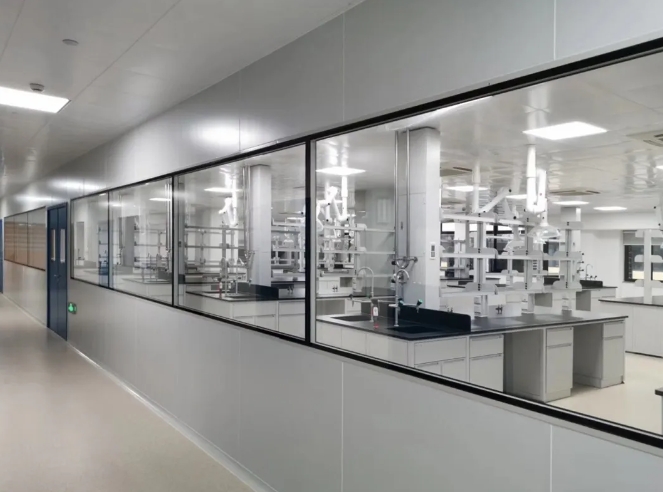Table of Contents
Designing a pharmaceutical laboratory requires precision, compliance with regulatory standards, and a deep understanding of the unique requirements of the pharmaceutical industry. Unlike general industrial spaces, pharmaceutical labs must meet stringent safety and quality control measures to ensure that the drugs produced are safe, effective, and free of contaminants. In this article, we will provide comprehensive pharmaceutical lab design guidelines that are useful for both lab owners and designers aiming to meet industry standards and create efficient, compliant labs.
Importance of Proper Pharmaceutical Lab Design
The layout and functionality of a pharmaceutical lab can significantly impact the quality of the testing and production processes. A well-designed lab promotes workflow efficiency, supports accurate results, and ensures compliance with Good Manufacturing Practices (GMP). Furthermore, it reduces contamination risks and facilitates proper equipment use.
Pharmaceutical lab design must accommodate specialized functional rooms, support a clean environment, and consider factors like the location, space utilization, and regulatory requirements. The design should also anticipate future needs, allowing the laboratory to expand or adjust based on evolving testing methods or production increases.
Key Considerations for Pharmaceutical Lab Design
Compliance with International Standards
Pharmaceutical labs must adhere to regulatory standards, such as those outlined by the Food and Drug Administration (FDA), European Medicines Agency (EMA), and other international pharmaceutical inspection bodies. In addition to meeting GMP requirements, pharmaceutical lab design must consider the specific quality management specifications applicable to the country of operation. These regulations are designed to ensure the lab is capable of supporting accurate and safe testing, handling, and production of pharmaceutical products.
Functional Room Layout
The layout of a pharmaceutical laboratory is crucial for operational efficiency and contamination control. The following functional areas are commonly incorporated into a pharmaceutical lab design:
- General Analysis Areas: These include chemical labs for raw material, packaging, and finished product inspection, as well as general instrument rooms.
- Reagent and Standard Rooms: Dedicated spaces for the storage and preparation of chemical reagents and standards are necessary to maintain the accuracy of tests and experiments.
- Specialized Analysis Areas: High-precision rooms such as balance rooms, sterile inspection areas, microbiological testing rooms, and antibiotic testing rooms are integral to ensure quality control.
- Cleaning and Preparation Areas: Separate areas for cleaning, disinfection, and preparation, such as disinfection rooms and preparation rooms, help prevent cross-contamination.
Airflow and Cleanroom Management
A key element in pharmaceutical lab design is controlling the environment to avoid contamination, particularly in cleanrooms where sterile drug production occurs. A well-designed lab will include:
- Buffer Rooms: Buffer rooms serve as a transitional space between corridors and cleanrooms, with the air pressure in the buffer room being slightly higher to prevent external contamination. This airflow system ensures that particles from the corridor do not enter the cleanroom environment.
- Controlled Air Pressure: The pharmaceutical lab must maintain precise control over the air pressure in different areas to protect sensitive testing environments from contamination. The “high in the middle, low on both sides” air pressure system used in buffer rooms is a proven method to control airflow and reduce cross-contamination.
Workflow Efficiency and Flexibility
Designing for efficient workflow is essential in any pharmaceutical lab. The placement of functional rooms and equipment should minimize unnecessary movement and allow for smooth transitions between different stages of testing and production. A flexible pharmaceutical lab design also allows for easy adjustments or expansions as new technologies or methods are introduced.
For example, a central inspection room can be divided into sections that perform both physical and chemical analysis as well as biological analysis. This allows for greater adaptability and efficient management of resources.
Data Management and Security
Data management is critical in pharmaceutical labs, where accuracy and traceability are non-negotiable. As part of pharmaceutical lab design, labs should include dedicated data processing and storage areas. These may include computer rooms and archive rooms where sensitive data is securely stored and easily accessible for audits or inspections.
Safety and Personnel Considerations
Designers must ensure that the lab is not only safe for the products but also for the personnel working within it. Incorporating personnel rooms such as locker rooms and lounges is necessary for ensuring that employees can safely transition in and out of the lab environment. Additionally, the pharmaceutical lab design should include emergency exits, fire suppression systems, and appropriate signage to ensure the well-being of all staff.
Future-Proofing the Pharmaceutical Lab Design
Pharmaceutical labs must remain adaptable to future changes in technology, regulations, and production needs. Ensuring that your lab can easily incorporate new instruments, expand functional spaces, or adjust workflow is essential for long-term success. Considerations such as modular lab furniture, flexible equipment placement, and scalable infrastructure will allow the lab to evolve without significant redesign or downtime.
Conclusion
A well-thought-out pharmaceutical lab design is essential for ensuring regulatory compliance, operational efficiency, and the safety of both products and personnel. Lab owners and designers must work closely to create a layout that balances functionality, safety, and flexibility, all while adhering to GMP standards and other regulatory requirements. Incorporating the right mix of functional rooms, cleanroom management, and future-proofing measures will result in a lab that supports high-quality pharmaceutical production for years to come.
By following these guidelines, both lab owners and designers can ensure they create pharmaceutical laboratories that not only meet today’s standards but are prepared for the future of the pharmaceutical industry.




